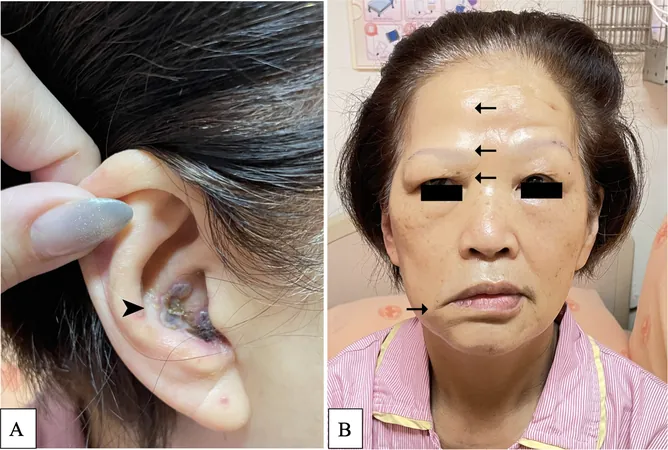
Early Recognition and Treatment of Ramsay Hunt Syndrome: A Life-Changing Case Report
2025-01-02
Author: Arjun
Introduction to Ramsay Hunt Syndrome
Ramsay Hunt Syndrome (RHS) is a rare yet serious complication arising from the reactivation of the varicella-zoster virus (VZV), the same virus responsible for chickenpox. This neurological condition is characterized by ipsilateral facial paralysis, intense ear pain, and a distinctive vesicular rash, typically found in the ear canal or on the auricle. Timely and thorough diagnosis is essential as it allows for the initiation of effective treatment, improving patient outcomes and minimizing potential complications.
A Remarkable Case Study
We present the case of a 67-year-old woman, who recently sought emergency medical care due to alarming symptoms. She had been suffering from a 5-day history of escalating discomfort in her right ear. Upon evaluation, the patient displayed classical signs of RHS: severe ear pain, facial drooping on the right side, and the appearance of fluid-filled blisters. Swift intervention, utilizing antiviral medications and glucocorticoids, resulted in substantial improvement in her symptoms.
Clinical Features and Diagnosis
Initially, the patient reported tingling pain in her right ear, which quickly evolved into clear facial asymmetry and weakened eye closure on the affected side. The day before admission, her condition worsened as ear pain intensified, and she noticed blisters developing around her right ear. Notably, she had no prior notable medical history, and her vitals appeared stable on assessment. Visual examinations confirmed the presence of vesicular lesions, and a clear diagnosis of RHS was made.
Treatment and Recovery
After diagnosis, the patient received a course of intravenous acyclovir along with a daily regimen of methylprednisolone over a nine-day hospitalization period. An electromyography (EMG) test conducted before her discharge indicated an ongoing nerve repair process. By the time she was sent home, the patient exhibited significant clinical improvement, although complete facial function had not been fully restored. She was discharged with a tailored tapering regimen of oral glucocorticoids and follow-up instructions.
Key Considerations for Healthcare Providers
Facial palsy, especially when accompanied by distinct symptoms like ear pain and rash, demands a thorough evaluation as it could indicate RHS. Quick diagnosis is instrumental in differentiating RHS from other causes of facial paralysis, particularly Bell’s palsy, which has a more favorable prognosis compared to RHS if left untreated. Providers must diligently assess facial muscle function, focusing on the forehead muscles to distinguish between central and peripheral nerve problems effectively.
The Importance of Early Intervention
RHS is relatively uncommon, yet when caught early, it has an encouraging recovery rate. Studies show that up to 70% of RHS patients regain full facial nerve function with immediate medical treatment. This reinforces the necessity for healthcare practitioners to remain vigilant and maintain a high index of suspicion for RHS in relevant patients.
Final Thoughts
The case of this 67-year-old woman illustrates that early recognition and intervention for Ramsay Hunt Syndrome can dramatically alter the clinical course and improve patient outcomes, adding to the growing body of evidence underscoring the importance of prompt diagnosis and treatment in neurological conditions. As awareness of RHS increases among healthcare providers, we can potentially decrease the incidence of long-term complications associated with this condition.
Stay Informed!
If you've experienced any symptoms similar to those discussed, or know someone who has, seek professional medical advice. Early action can make all the difference in combating Ramsay Hunt Syndrome and other health challenges. Remember, knowledge is your best defense against these unexpected health crises!
 Brasil (PT)
Brasil (PT)
 Canada (EN)
Canada (EN)
 Chile (ES)
Chile (ES)
 Česko (CS)
Česko (CS)
 대한민국 (KO)
대한민국 (KO)
 España (ES)
España (ES)
 France (FR)
France (FR)
 Hong Kong (EN)
Hong Kong (EN)
 Italia (IT)
Italia (IT)
 日本 (JA)
日本 (JA)
 Magyarország (HU)
Magyarország (HU)
 Norge (NO)
Norge (NO)
 Polska (PL)
Polska (PL)
 Schweiz (DE)
Schweiz (DE)
 Singapore (EN)
Singapore (EN)
 Sverige (SV)
Sverige (SV)
 Suomi (FI)
Suomi (FI)
 Türkiye (TR)
Türkiye (TR)
 الإمارات العربية المتحدة (AR)
الإمارات العربية المتحدة (AR)